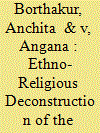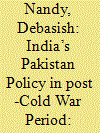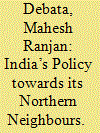|
|
|
Sort Order |
|
|
|
Items / Page
|
|
|
|
|
|
|
| Srl | Item |
| 1 |
ID:
166836


|
|
|
|
|
| Summary/Abstract |
Rising insurgent groups and non-traditional security forces helped the international actors justifying their presence in Afghanistan. The weak and fragmented international effort towards reconstruction and reconciliation process led to a more complex and complicated situation. Even after the prolonged engagement of ISAF and an enormous inflow of foreign aid, socio economic and political conditions remained deteriorated in Afghanistan. With the recent withdrawal of international security forces from Afghanistan, a new external security dilemma has taken shape for the actors involved there. Most of the international actors focused on the security sector development in order to bring the opposition into the negotiation table on suitable terms.
|
|
|
|
|
|
|
|
|
|
|
|
|
|
|
|
| 2 |
ID:
166838


|
|
|
|
|
| Summary/Abstract |
India and Central Asia have a long history that can be traced back to antiquity. Though both the regions have been geographically separated, there has been a continuous exchange of ideas and intellect amongst the people of the two regions. India and Central Asia are interconnected in several ways and have shared deep dimensions of social, cultural and economic linkages. These historical and civilizational influences are vast and multidimensional covering a whole range of aspects. In this context, this paper emphasises the impact both the regions leave on their cultural and historical development since ancient times.
|
|
|
|
|
|
|
|
|
|
|
|
|
|
|
|
| 3 |
ID:
166832


|
|
|
|
|
| Summary/Abstract |
The Afghan conflict, which formally started with the Soviet invasion of Afghanistan in late 1979, led to resistance movements throughout the country. The Mujahedeen resistance movement which began as a collective struggle against an infidel foreign power soon changed its course by promoting internal fighting’s within the groups based on ethno-religious lines. The politics behind the Afghan resistance was played by using both ethnic and religious cards, resulted into internal splits within the resistance. The ideological differences in relation to Islam among the warring factions of the movement had further complicated the situation. This paper will be an attempt to highlight the ethno-religious deconstruction of the Mujahedeen resistance movement in Afghanistan and its implication on its neighborhood. The role of foreign powers with their respective interests in supporting the Mujahedeen groups will also be analyzed in this paper.
|
|
|
|
|
|
|
|
|
|
|
|
|
|
|
|
| 4 |
ID:
166844


|
|
|
|
|
| Summary/Abstract |
In the light of India’s policy of growing ties with India’s extended neighborhood, Central Asia Region (CAR) has become an important expanse in India’s foreign policy. Kyrgyzstan is an important neighbor for India since the days of Ancient Silk Route. After attaining independence in 1991 from the USSR, Kyrgyzstan became the only Central Asian state to adopt democracy as a form of government. It was also addressed as an ‘Island of Democracy’ for its pluralist polity in the sea of authoritarian and despotic regimes of CAR.
|
|
|
|
|
|
|
|
|
|
|
|
|
|
|
|
| 5 |
ID:
166846


|
|
|
|
|
| Summary/Abstract |
India, which joined the Shanghai Cooperation Organization (SCO) with an Observer status in the year 2005, became a full-fledged member in 2017, during the SCO annual Summit in Kazakh capital Astana. This not only provides a leeway to India’s endeavour to keep its northern neighbours in good humour by building meaningful strategic partnership, but also to resurrect its ambition to become an important force in the Eurasian region.
|
|
|
|
|
|
|
|
|
|
|
|
|
|
|
|
| 6 |
ID:
166831


|
|
|
|
|
| Summary/Abstract |
The crux of Indo-Pak relations is confined within hard diplomacy. The arms race and process of militarization have vehemently affected bilateral relations between the Stwo neighbours. When a relationship starts with antagonism, then it might hardly transform into friendship. Both countries are federal with plural society. While Pakistan is the worst example of pluralism, India is a classic example of pluralistic idea. Regarding multiculturalism and communal tolerance, India’s perception is different from Pakistan. Pakistan had built up close ties with Islamic states, which has a dual purpose to seek an Islamic identity on one hand and obtain economic assistance on the other. It is in this context, this paper will try to examine India’s policy towards Pakistan, especially during Narendra Modi’s first tenure as Prime Minister and the role of external powers in Indo-Pak relations.
|
|
|
|
|
|
|
|
|
|
|
|
|
|
|
|
| 7 |
ID:
166830


|
|
|
|
|
| Summary/Abstract |
The importance of India’s northern neighbourhood is ironically felt and redoubled in the post-Cold War period following the disintegration of erstwhile Soviet Union. In the northern neighbourhood, there is a potential enemy (Pakistan) with whom India has fought four wars in the last seven decades or so; there is a fierce competitor, economically and militarily superior (China) power that continues to pose serious challenges to India every here and there; there are resource-rich regions-cum-friendly nations such as Central Asia and Mongolia; and also there is a war-torn shattered security zone (Afghanistan). Amidst challenges and opportunities, India has been considering this region as key to maximize its national interests and international goals in this region, and thus trying to maintain a balance with a set of foreign policy measures.
|
|
|
|
|
|
|
|
|
|
|
|
|
|
|
|
| 8 |
ID:
166833


|
|
|
|
|
| Summary/Abstract |
This article argues that the fall of the Taliban regime in 2001 has drawn India much closer to Afghanistan. The existing bilateral ties have been significantly boosted from 2011 onwards with the inking of the Strategic Partnership Agreement. Contributing over $1 billion, India has become the fifth largest donor and is now the largest regional donor for Afghan reconstruction. India has been effective in giving economic leverage to Afghanistan through developmental assistance. At the present state of things, India should be deepening its presence in Afghanistan while comforting Pakistan for a peaceful neighbourhood. Given the geo-strategic and economic necessity, India should development-wise engage more to neutralize the interventions of Pakistan and play a key role in the region.
|
|
|
|
|
|
|
|
|
|
|
|
|
|
|
|
| 9 |
ID:
166834


|
|
|
|
|
| Summary/Abstract |
Since Afghanistan is strategically crucial for India, a strong and vibrant economic relationship with Afghanistan is, therefore, of critical value and relevance for India. In view of India’s relations with its close neighbour Pakistan, Afghanistan attaches further significance for India. Close and stable relations with Afghanistan are possible through sustained and growing trade and investment relations. Afghanistan is blessed with enormous resources and because of its geographical position will become an energy corridor (for TAPI gas pipeline) in the future that would be of considerable importance to India. As a growing and large economy, India needs more energy resources to sustain her high economic growth. Against this background, this paper has highlighted the bilateral trade potential and modest attempt has made towards in depicting Afghanistan as potential and important country for India in terms of geo-strategic, geo-political and geo-economic factors.
|
|
|
|
|
|
|
|
|
|
|
|
|
|
|
|
| 10 |
ID:
166839


|
|
|
|
|
| Summary/Abstract |
India and Central Asia had historically good memories of engagement. With the help of the Silk Route and other caravan routes, ancient and medieval India was connected deeply with the Central Asian region. Many archaeological sources have provided references to the flow of movements among the two regions. Excavations at various sites have also provided the evidence of mutual relations among these two neighbouring regions. The flow of people, ideas, cultures, and art and painting have been witnessed in the ancient and medieval times.
|
|
|
|
|
|
|
|
|
|
|
|
|
|
|
|
| 11 |
ID:
166840


|
|
|
|
|
| Summary/Abstract |
India-Central Asia shares warm and friendly relations, which has had a long history with ancient roots. Central Asia comprises five former Soviet Republics: Kazakhstan, Kyrgyzstan, Tajikistan, Turkmenistan and Uzbekistan. India and Central Asia have deep linkages which had developed through trade, commerce and people to people contact for over more than two millennia. In the present context, India-Central Asia engages with each other in different area, be it defence, military, political, economic and cultural spheres.
|
|
|
|
|
|
|
|
|
|
|
|
|
|
|
|
| 12 |
ID:
166837


|
|
|
|
|
| Summary/Abstract |
This paper unravels the narrative of Indian foreign policy, which is being conditioned to be more pragmatic and realistic these days. Our relationship with neighbouring states evolving in a very strategic direction which makes us to nurture the idea of ‘neighbour’s first’. The article mainly focuses on post 9/11 scenario where the US has lunched ‘War on Terror’. The paper discusses how the relations of India and EU with Afghanistan have been trying to establish common amenities of life like education, health care, human rights, infrastructure and democratic governance at national and regional level. The paper analyzes further how the EU and India has established a convergence to help Afghanistan out in its own path for reconstruction by means of establishing various institutions like Army, Police, and Democratic set ups, Public Administration and especially civil education and health care.
|
|
|
|
|
|
|
|
|
|
|
|
|
|
|
|
| 13 |
ID:
166845


|
|
|
|
|
| Summary/Abstract |
India and Tajikistan has been linked to each other since time immemorial. Eventhough both face the physical obstruction of high Himalayan and Hindukush mountain ranges, they have not failed to secure their socio-economic and historical-cultural relations as an important segment their bilateral relations. This paper has given the overview of India-Tajikistan relations, especially the historical and cultural linkages between the two countries, and their bilateral relations, strategic cooperation and security issues that concern both the countries.
|
|
|
|
|
|
|
|
|
|
|
|
|
|
|
|
| 14 |
ID:
166843


|
|
|
|
|
| Summary/Abstract |
India’s increasing economic capabilities and geopolitical vitality has amplified its aspiration of reconnecting with Central Asia. In this direction, India-Uzbekistan relations have the potential to go beyond their current status. Nevertheless, India needs to explore the untapped potential of Uzbekistan. This paper presents an analytical view of India-Uzbekistan bilateral relations especially after they signed ‘Strategic Partnership Agreement’ in 2011.
|
|
|
|
|
|
|
|
|
|
|
|
|
|
|
|
| 15 |
ID:
166842


|
|
|
|
|
| Summary/Abstract |
Though still a work in progress, the Caspian pipeline politics have mutated and matured over the years, often oscillating between the geopolitical considerations and geoeconomic imperatives of the stakeholders involved. Despite being a region of utmost geostrategic importance across India’s extended neighbourhood, the Central Asia—Transcaucasia belt, comprising the Caspian Basin, eluded the Indian foreign policy radar for many years. There is, however, an increasing realisation lately among India’s policy elite, of the veritable need to put paid to the strategic lethargy of the yesteryears.
|
|
|
|
|
|
|
|
|
|
|
|
|
|
|
|
| 16 |
ID:
166847


|
|
|
|
|
| Summary/Abstract |
The democratic reforms together with the changed external geostrategic environment following the Soviet collapse created a favourable situation for Mongolia to conduct its post-Cold War foreign policy based on realism and national interest.As outlined in the Concept of Foreign Policy Mongolia began maintaining a balance in relations with the two neighbours - Russia and China in addition to building closer ties with partners other than these two neigbhours.
|
|
|
|
|
|
|
|
|
|
|
|
|
|
|
|
| 17 |
ID:
166841


|
|
|
|
|
| Summary/Abstract |
Jadidism was a movement of the late 19th and early 20th centuries in the Russian Empire that aimed at the multi-dimensional advancement of the Muslim society. Muslims here by then were very reactionary and had decayed much to which Jadids found out the solutions because they had acquired modern knowledge. Education based on a new methodology that included both religious and secular education was taken as its main tool. They recommended western education for students such as humanities and science subjects as they can acquaint them with reality.
|
|
|
|
|
|
|
|
|
|
|
|
|
|
|
|
| 18 |
ID:
166835


|
|
|
|
|
| Summary/Abstract |
Afghanistan, also known as the ‘Heart of Asia’, links distinct civilizations from South to Central Asia and the Middle East. For a long time, due to its important strategic location, and old Silk Route), Afghanistan had become the centre of attraction because various empires wanted to expand their powers, and this has reflected in the post-9/11 period in a different degree. Some regional and international actors took advantage of the situation and supported the insurgents with all their means. It was only when the situation within the country started showing its external impacts that the world began to take some serious actions. Since 2001, numerous peace processes have been initiating by the United Nations (UN) and various other international and regional players in order to bring peace and stability in Afghanistan.
|
|
|
|
|
|
|
|
|
|
|
|
|
|
|
|
| 19 |
ID:
166848


|
|
|
|
|
| Summary/Abstract |
Afghanistan has been the playground for major powers of the world for last so many years. It has been the victim of “The Great Game” which was a political and diplomatic confrontation prevalent throughout the 19th century between the British Empire and the Russian Empire over Afghanistan and neighbouring territories. Taking cue from there noted journalist Ahmad Rashid wrote a book in the year 2000 titled Taliban: Islam, Oil and The Great New Game in Central Asia.
|
|
|
|
|
|
|
|
|
|
|
|
|
|
|
|
|
|
|
|
|